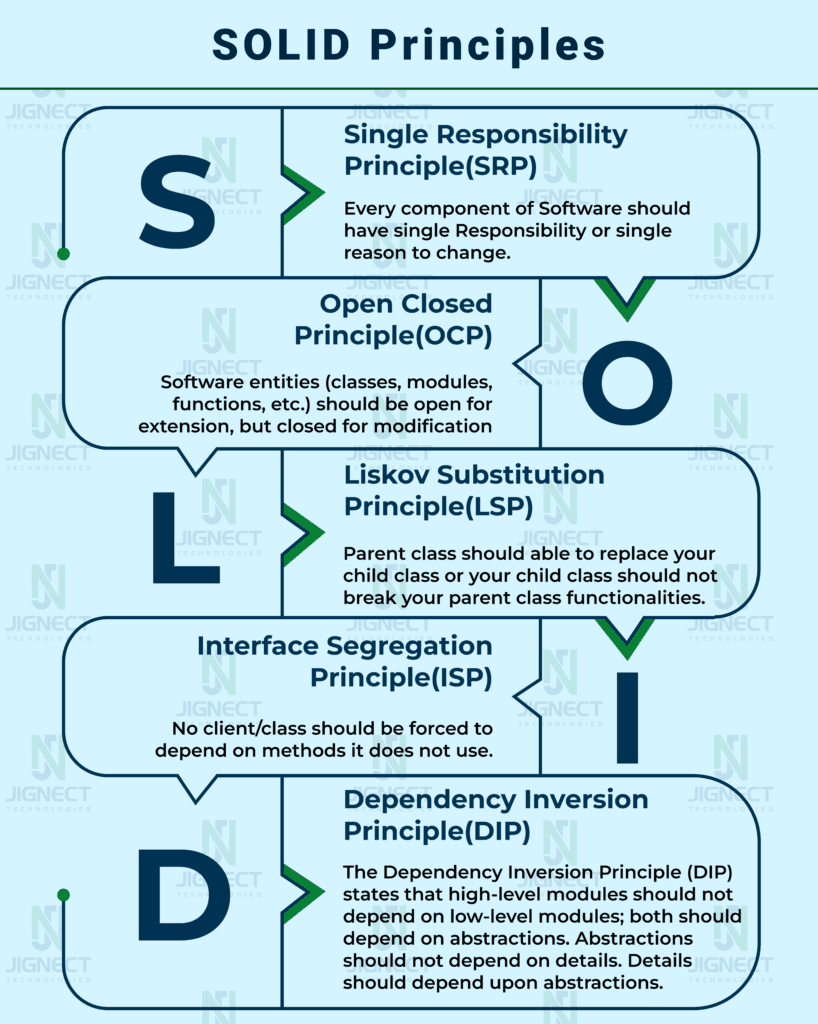Understanding the Core of SOLID Principles in Object-Oriented Programming solid principles are crucial for any QA professional aiming to ensure high-quality software. SOLID principles encompass solid coding principles, solid programming principles, and solid object-oriented principles, all designed to make the code more maintainable, scalable, and robust. By adhering to these guidelines, QA teams can create systems that are easier to understand, test, and debug, ultimately leading to a more efficient and effective testing process. In this blog, we will delve into each of the SOLID principles, exploring their significance and how they can be applied to enhance your software testing and quality assurance practices.
𝗦𝗢𝗟𝗜𝗗 𝗿𝗲𝗽𝗿𝗲𝘀𝗲𝗻𝘁𝘀 𝗳𝗶𝘃𝗲 𝗽𝗿𝗶𝗻𝗰𝗶𝗽𝗹𝗲𝘀 𝗼𝗳 𝗼𝗯𝗷𝗲𝗰𝘁-𝗼𝗿𝗶𝗲𝗻𝘁𝗲𝗱 𝗽𝗿𝗼𝗴𝗿𝗮𝗺𝗺𝗶𝗻𝗴. Whether or not you use OOP, 𝗸𝗻𝗼𝘄𝗶𝗻𝗴 𝘁𝗵𝗲𝘀𝗲 𝗽𝗿𝗶𝗻𝗰𝗶𝗽𝗹𝗲𝘀 𝗴𝗶𝘃𝗲𝘀 𝘆𝗼𝘂 𝗮 𝗹𝗲𝗻𝘀 𝗶𝗻𝘁𝗼 𝘁𝗵𝗲 𝗳𝗼𝘂𝗻𝗱𝗮𝘁𝗶𝗼𝗻𝘀 𝗼𝗳 𝗰𝗹𝗲𝗮𝗻 𝗰𝗼𝗱𝗲 which can be applied to many areas of programming.
🔹𝗦 — Single Responsibility Principle
🔹𝗢 — Open/Closed Principle
🔹𝗟 — Liskov Substitution Principle
🔹𝗜 — Interface Segregation Principle
🔹𝗗 — Dependency Inversion Principle

Let’s break down each principle ⤵️
1️⃣ 𝗦𝗶𝗻𝗴𝗹𝗲 𝗥𝗲𝘀𝗽𝗼𝗻𝘀𝗶𝗯𝗶𝗹𝗶𝘁𝘆 𝗣𝗿𝗶𝗻𝗰𝗶𝗽𝗹𝗲 (𝗦𝗥𝗣)
Each unit of code should only have one job or responsibility. A unit can be a class, module, function, or component. This keeps code modular and removes the risk of tight coupling.
2️⃣ 𝗢𝗽𝗲𝗻-𝗖𝗹𝗼𝘀𝗲𝗱 𝗣𝗿𝗶𝗻𝗰𝗶𝗽𝗹𝗲 (𝗢𝗖𝗣)
Units of code should be open for extension but closed for modification. You should be able to extend functionality with additional code rather than modifying existing ones. This principle can be applied to component-based systems such as a React frontend.
3️⃣ 𝗟𝗶𝘀𝗸𝗼𝘃 𝗦𝘂𝗯𝘀𝘁𝗶𝘁𝘂𝘁𝗶𝗼𝗻 𝗣𝗿𝗶𝗻𝗰𝗶𝗽𝗹𝗲 (𝗟𝗦𝗣)
The Liskov Substitution Principle (LSP) is a fundamental principle of object-oriented design that states that objects of a superclass should be able to be replaced with objects of a subclass without affecting the correctness of the program.
For example, imagine a Vehicle base class with a move() method. If we create subclasses like Car and Bicycle, both must implement move() in a way that adheres to the behavior expected of a Vehicle. If a subclass, say Boat, implements move() differently and violates the expectation (like needing water instead of a road), it would break LSP.
To follow LSP, subclasses must ensure they can replace the base class without changing how the program behaves.
4️⃣ 𝗜𝗻𝘁𝗲𝗿𝗳𝗮𝗰𝗲 𝗦𝗲𝗴𝗿𝗲𝗴𝗮𝘁𝗶𝗼𝗻 𝗣𝗿𝗶𝗻𝗰𝗶𝗽𝗹𝗲 (𝗜𝗦𝗣)
Provide multiple interfaces with specific responsibilities rather than a small set of general-purpose interfaces. Clients shouldn’t need to know about the methods & properties that don’t relate to their use case.
- Complexity ↓
- Code flexibility ↑
5️⃣ 𝗗𝗲𝗽𝗲𝗻𝗱𝗲𝗻𝗰𝘆 𝗜𝗻𝘃𝗲𝗿𝘀𝗶𝗼𝗻 𝗣𝗿𝗶𝗻𝗰𝗶𝗽𝗹𝗲 (𝗗𝗜𝗣)
You should depend on abstractions, not on concrete classes. Use abstractions to decouple dependencies between different parts of the systems. Direct calls between units of code shouldn’t be done, instead interfaces or abstractions should be used.
Conclusion 👇
In summary, the SOLID principles are significant because they guide developers in creating software that is more maintainable, extensible, and robust. By following these principles, developers can reduce code complexity, minimize the risk of introducing bugs, and ensure that their systems are adaptable to changing requirements. If you want to learn more about SOLID principles, check out this blog: Examples of SOLID Principles in Test Automation.
Witness how our meticulous approach and cutting-edge solutions elevated quality and performance to new heights. Begin your journey into the world of software testing excellence. To know more refer to Tools & Technologies & QA Services.
If you would like to learn more about the awesome services we provide, be sure to reach out.
Happy Testing 🙂




